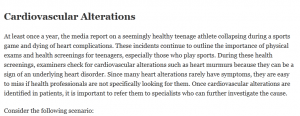Cardiovascular Alterations

At least once a year, the media report on a seemingly healthy teenage athlete collapsing during a sports game and dying of heart complications. These incidents continue to outline the importance of physical exams and health screenings for teenagers, especially those who play sports. During these health screenings, examiners check for cardiovascular alterations such as heart murmurs because they can be a sign of an underlying heart disorder. Since many heart alterations rarely have symptoms, they are easy to miss if health professionals are not specifically looking for them. Once cardiovascular alterations are identified in patients, it is important to refer them to specialists who can further investigate the cause.
Consider the following scenario:
A 16-year-old male presents for a sports participation examination. He has no significant medical history and no family history suggestive of risk for premature cardiac death. The patient is examined while sitting slightly recumbent on the exam table and the advanced practice nurse appreciates a grade II/VI systolic murmur heard loudest at the apex of the heart. Other physical findings are within normal limits, the patient denies any cardiovascular symptoms, and a neuromuscular examination is within normal limits. He is cleared with no activity restriction. Later in the season he collapses on the field and dies.
To Prepare
Review the scenario provided, as well as Chapter 25 in the Huether and McCance text. Consider how you would diagnose and prescribe treatment for the patient.
Select one of the following patient factors: genetics, ethnicity, or behavior. Reflect on how the factor you selected might impact diagnosis and prescription of treatment for the patient in the scenario.
Post a description of how you would diagnose and prescribe treatment for the patient in the scenario. Then explain how the factor you selected might impact the diagnosis and prescription of treatment for that patient.
Required Readings
** Huether, S. E., & McCance, K. L. (2017). Understanding pathophysiology (6th ed.). St. Louis, MO: Mosby.
Chapter 23, “Structure and Function of the Cardiovascular and Lymphatic Systems”
This chapter examines the circulatory system, heart, systemic circulation, and lymphatic system to establish a foundation for normal cardiovascular function. It focuses on the structure and function of various parts of the circulatory system to illustrate normal blood flow.
Chapter 24, “Alterations of Cardiovascular Function”
This chapter presents the pathophysiology, clinical manifestations, evaluation, and treatment of various cardiovascular disorders. It focuses on diseases of the veins and arteries, disorders of the heart wall, heart disease, and shock.
Chapter 25, “Alterations of Cardiovascular Function in Children”
This chapter examines cardiovascular disorders that affect children. It distinguishes congenital heart disease from acquired cardiovascular disorders.
** Hammer, G. G. , & McPhee, S. (2014). Pathophysiology of disease: An introduction to clinical medicine. (7th ed.) New York, NY: McGraw-Hill Education.
Chapter 11, “Cardiovascular Disorders: Vascular Disease”
This chapter begins with an overview of the vascular component of the cardiovascular system and how the cardiovascular system is normally regulated. It then describes three common vascular disorders: atherosclerosis, hypertension, and shock.
**American Heart Association. (2012). Retrieved from http://www.heart.org/HEARTORG/
**Million Hearts. (2012). Retrieved from http://millionhearts.hhs.gov/index.html
**National Heart, Lung, and Blood Institute. (2012). Retrieved from http://www.nhlbi.nih.gov/
Instructor Requirements
As advanced practice nurses, we are scholars, nurse researchers and scientists. As such, please use Peer-Reviewed scholarly articles and websites designed for health professionals (not designed for patients) for your references. Students should be using the original citation in Up
to Date and go to that literature as a reference. The following are examples (not all inclusive) of resources/websites deemed inadmissible for scholarly reference:
1. Up to Date (must use original articles from Up to Date as a resource)
2. Wikipedia
3. Cdc.gov- non healthcare professionals section
4. Webmd.com
5. Mayoclinic.com
– This work should have Introduction and Conclusion
– It should have at least 3 current references
– APA format
– At least 2 pages, references page not included